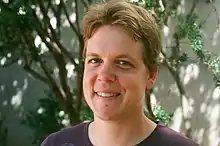Katrin Wehrheim
Katrin Wehrheim (born 1974) is an associate professor of mathematics at the University of California, Berkeley. Their research centers around symplectic topology and gauge theory. They are known for their work on pseudoholomorphic quilts. With Dusa McDuff, they have challenged the foundational rigor of a classic proof in symplectic geometry.[1]
Katrin Wehrheim | |
|---|---|
 Wehrheim at Berkeley, California 2013 | |
| Born | 1974 |
| Nationality | German |
| Alma mater | ETH Zürich |
| Awards |
|
| Scientific career | |
| Fields | Mathematics |
| Institutions | |
| Thesis | Anti-self-dual instantons with Lagrangian boundary conditions (2002) |
| Doctoral advisor | |
Education and career
After attending school in Hamburg[2] and studying at the University of Hamburg until 1995 and Imperial College until 1996, Wehrheim went to ETH Zürich for graduate studies. After almost dropping out to become an Olympic rower, Wehrheim completed their PhD in 2002, under the joint supervision of Dusa McDuff and Dietmar Salamon.[3]
They were an instructor at Princeton University and member of the Institute for Advanced Study before taking a tenure track position at the Massachusetts Institute of Technology in 2005.[4] While they were at MIT, Wehrheim—who is openly gay—co-headed the 2008 Celebration of Women in Mathematics conference[4] and assisted the institute in a push to bring on students and postdoctoral researchers from diverse backgrounds.[5] Since 2013, Wehrheim has been teaching mathematics at the University of California, Berkeley.[6]
Awards and honors
Their PhD thesis in mathematics Anti-Self-Dual Instantons with Lagrangian Boundary Conditions won the 2002 ETH medal.[3] In 2010 they received the Presidential Career Award PECASE from Barack Obama in a ceremony at the White House.[7] In 2012 they became a fellow of the American Mathematical Society.[8]
References
- Hartnett, Kevin (February 9, 2017), "A Fight to Fix Geometry's Foundations: When two mathematicians raised pointed questions about a classic proof that no one really understood, they ignited a years-long debate about how much could be trusted in a new kind of geometry", Quanta.
- "Hamburg ehrte seine jungen Sieger". Hamburger Abendblatt. Springer. 9 December 1988. Archived from the original on September 28, 2009. Retrieved 2009-11-19.
- "Katrin Wehrheim - The Mathematics Genealogy Project". www.genealogy.math.ndsu.nodak.edu. Retrieved 2018-12-05.
- Murray, Margaret A.M. (January 2009). "A Celebration of Women in Mathematics at MIT" (PDF). Notices of the AMS. American Mathematical Society. 56 (1): 42, 44, 45.
- "Katrin Wehrheim – Women In Math". math.mit.edu. Retrieved 2021-08-28.
- "Katrin Wehrheim | Department of Mathematics at University of California Berkeley". math.berkeley.edu. Retrieved 2018-12-05.
- "President Names Nation's Top Early Career Scientists and Engineers" (Press release). National Science Foundation. November 9, 2010. Retrieved 2012-11-29.
- List of Fellows of the American Mathematical Society, retrieved 2013-09-01.